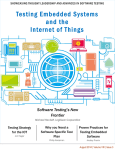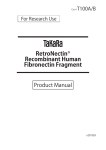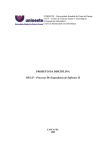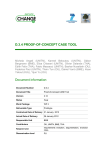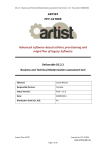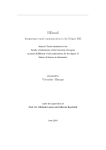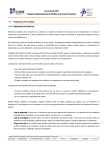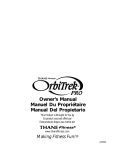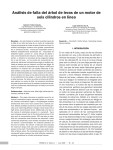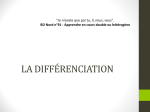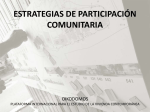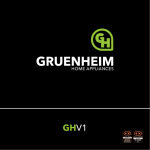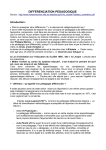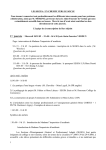Download Socialización de resultados - Universidad Nacional de Colombia
Transcript
Apéndice A Socialización de resultados Bien está lo que bien acaba Esta tesis presentó sus resultados a la consideración de evaluadores externos. Primero como ponencia en un evento internacional organizado por la IEEE Sección Centro Occidente de México [Serna:2010]; y posteriormente con un artículo publicado en la revista Iteckne de la Universidad Santo Tomás, clasificada en categoria C por Publindex [Serna:2100b]. La Figura A.1 muestra el certificado de participación en la XII Reunión de Otoño de Potencia, Electrónica y Computación - ROPEC’2010 INTERNACIONAL, mientras que la Figura A.2 muestra la primera página del artículo publicado en las memorias de dicho evento. La Figura A.3 muestra la tabla de contenido de la revista Iteckne donde se evidencia la publicación del artículo, mientras que la Figura A.4 muestra la primera página del artículo que se publicó en dicha revista. 129 130 A Socialización de resultados Figura A.1: Certificado como ponente en ROPEC’2010 A Socialización de resultados Figura A.2: Primera página del artículo publicado en las memorias de ROPEC’2010 131 132 A Socialización de resultados Figura A.3: Tabla de contenido de la revista Iteckne Vol. 7, No. 1, Julio 2010 A Socialización de resultados Figura A.4: Primera página del artículo publicado en la revista Iteckne Vol. 7, No. 1, Julio 2010 133 Glosario Atributo Es información que representa el estado de un objeto. Característica Cualidad que determina los rasgos de una persona o cosa y la distingue claramente de las demás. Clasificador Es una clasificación de instancias, el cual describe un conjunto de instancias que tienen un conjunto de características en común. El clasificador es una metaclase abstracta. Línea de vida Representa uno y sólo un participante en un diagrama de interacción. Mensaje Permite definir comunicaciones particulares entre líneas de vida de un diagrama de de interacción. La comunicación puede ser una señal, la invocación de una operación, o la creación o destrucción de una instancia. Método Es la implementación de una operación. Operación Es una abstracción que indica la declaración de un cierto comportamiento de una clase. Operacionalización Es la puesta en funcionamiento de un NFR, esto se puede hacer cuando el NFR está lo suficientemente refinado y por lo tanto se puede identificar una posible técnica de desarrollo con el fin de satisfacerlo. Performance Se traduce al español como desempeño, y define la eficacia de un sistema de cómputo. Propiedad Es una característica estructural. Puede representar un atributo de un clasificador o un extremo de una asociación. Restricción Es una condición o limitación expresada en un lenguaje, formal o no, con el fin de dar mayor claridad sobre la semántica de un elemento. Satisfacibilidad Es una medida cualitativa del grado en el cual un requisito se satisface en el sistema. Cuando se habla de grado de satisfacibilidad, se refiere al hecho de que un requisito no se cumplió completamente, sólo en cierto grado pudo satisfacerse. El nivel de satisfación normalmente no se expresa en forma cuantitativa, sino en forma cualitativa, como parcialmente satisfecho o parcialmente insatisfecho. 135 136 Glosario Softgoal Es un objetivo que no necesariamente tiene un criterio absolutamente claro de satisfacibilidad. Algunos pueden ser medidos y cuantificados, pero se utilizan sobretodo en enfoques cualitativos. Las relaciones entre softgoal no son tan rígidas como entre los objetivos, relaciones del tipo AND – OR, más bien se enmarcan en relaciones más suaves, que permiten razonar acerca de contribuciones entre ellos. Las contribuciones pueden ser positivas – negativas, o completas – parciales. Throughput Se traduce al español como rendimiento, y define la cantidad de trabajo, puede ser tareas, métodos, entre otras, que realiza un sistema de cómputo por unidad de tiempo. Referencias [Allen:1997] Garlan D. Allen, R. A formal basis for architectural connection. ACM Transactions on Software Engineering and Methodology, 6(3):213–249, 1997. cited By (since 1996) 438. [Anton:1997] Ana I. Anton. Goal identification and refinement in the specification of software-based information systems. PhD thesis, Atlanta, GA, USA, 1997. [Arango:2006] Fernando Arango and Carlos Mario Zapata. UN-Método para la elicitación de requisitos de software. Escuela de Sistemas Universidad Nacional de Colombia, Medellín, 2006. [Beck:2000] K. Beck. Extreme Programming Explained: Embrace Change. Addison-Wesley, 2000. [Bertagnolli:2003] Silvia de Castro Bertagnolli and Maria Lúcia Blanck Lisbôa. The frida model. In Proc. of Workshop on Analysis Aspect-Oriented Software, Germany, 2003. [Boehm:1976] J. R. Brown B. Boehm and M. Lipov. Quantitative evaluation of software quality. In Proc. 2nd IEEE International Conference on Software Engineering, pages 592–605, San Francisco, California, United States, 1976. [Booch:2006] Grady Booch, James Rumbaugh, and Ivar Jacobson. El lenguaje unificado de modelado : guía del usuario. Pearson Educación S.A., Madrid, 2 edition, 2006. [Botella:2001] Pere Botella, Xavier Burgues, Xavier Franch, Mario Huerta, and Guadalupe Salazar. Modelling non-functional requirements. In Proceedings of Jornadas Ingeniera de Requisitos Aplicados (JIRA), Sevilla, Spain, 2001. [Burge:2002] J. Burge and D. Brown. Nfrs: Fact or fiction? Technical Report WPI-CS-TR-02-01, Computer Science Technical Report Worcester Polytechnic University, 2002. [Chandrasekaran:2000] B. Chandrasekaran and John R. Josephson. Representing function as effect. In Engineering with Computers, Special Issue on Computer Aided Engineering, pages 162–177, 2000. [Chung:1995] Lawrence Chung and Brian A. Nixon. Dealing with non-functional requirements: Three experimental studies of a processoriented approach. In Software Engineering, 1995. ICSE 1995. 17th International Conference on, pages 25 –25, april 1995. [Chung:2000] Lawrence Chung, Brian A. Nixon, Eric Yu, and John Mylopoulos. Non-functional requirements in software engineering. Kluwer Academic Publishers Group, 2000. [Coad:1999] Jeff De Luca Peter Coad, Eric Lefebvre. Java Modeling In Color With UML: Enterprise Components and Process. Prentice Hall PTR, 1999. [Cysneiros:2001] Luiz Marcio Cysneiros and Julio César Sampaio do Prado Leite. Using uml to reflect non-functional requirements. In CASCON ’01: Proceedings of the 2001 conference of the Centre for Advanced Studies on Collaborative research, page 2. IBM Press, 2001. [Cysneiros:2001a] Luiz Marcio Cysneiros and Julio César Sampaio do Prado Leite. Using the language extended lexicon to support nonfunctional requirements elicitation, 2001. [Cysneiros:2004] L.M. Cysneiros and J.C.S. do Prado Leite. Nonfunctional requirements: from elicitation to conceptual models. Software Engineering, IEEE Transactions on, 30(5):328–350, May 2004. [Dai:2005] Lirong Dai and Kendra Cooper. Modeling and analysis of non-functional requirements as aspects in a uml based architecture design. In SNPD-SAWN ’05: Proceedings of the Sixth International Conference on Software Engineering, Artificial Intelligence, Networking and Parallel/Distributed Computing and First ACIS International Workshop on Self-Assembling Wireless Networks, pages 178–183, Washington, DC, USA, 2005. IEEE Computer Society. [Dai:2006] Lirong Dai and Kendra Cooper. Modeling and performance analysis for security aspects. Science of Computer Programming, 61(1):58 – 71, 2006. Special Issue on Quality system and software architectures. [Dardenne:1993] Anne Dardenne, Axel Van Lamsweerde, and Stephen Fickas. Goal-directed requirements acquisition. In Science of Computer Programming, volume 20, pages 3–50, 1993. [Davis:1993] Alan M. Davis. Software requirements: objects, functions, and states. Prentice-Hall, Inc., Upper Saddle River, NJ, USA, 1993. [Fei:2007] Ye Fei and Zhu Xiaodong. An xml-based software non-functional requirements modeling method. In Electronic Measurement and Instruments, 2007. ICEMI ’07. 8th International Conference on, pages 2–375–2–380, 16 2007-July 18 2007. 137 138 Referencias [Flake:2002] Stephan Flake and Wolfgang Mueller. An ocl extension for real-time constraints. In Object Modeling with the OCL, The Rationale behind the Object Constraint Language, pages 150–171, London, UK, 2002. Springer-Verlag. [Flake:2002a] Stephan Flake and Wolfgang Mueller. A uml profile for real-time constraints with the ocl. In UML ’02: Proceedings of the 5th International Conference on The Unified Modeling Language, pages 179–195, London, UK, 2002. Springer-Verlag. [Freescale:2010] Rabbit A Digi International Brand. Hcs 08 family reference manual. Technical Report Part Number HCS08RMv1, Freescale Semiconductor, May 2007. [Hamilton:2006] Kim Hamilton and Russell Miles. Learning UML 2.0. O’Reilly, April 2006. [Harrington:1991] J. Harrington. Business Process Improvement: The Breakthrough Strategy for Total Quality, Productivity and Competitiveness. McGraw-Hill, 1991. [Hull:2005] Elizabeth Hull, Ken Jackson, and Jeremy Dick. Requirements Engineering. Springer, 2 edition, 2005. [IEEE1012:2005] IEEE. Ieee std 1012 - 2004 ieee standard for software verification and validation. Technical report, 2005. [IEEE802.15:2006] IEEE. Part 15.4: Wireless medium access control (mac) and physical layer (phy) specifications for low-rate wireless personal area networks (wpans). Technical report, September 2006. [IEEE830:1998] IEEE. Ieee recommended practice for software requirements specifications. Technical report, 1998. [IEEE:1990] Computer Society of the IEEE. Ieee standard glossary of software engineering terminology. Technical Report IEEE Std 610.12-1990, IEEE, 1990. [ISO/IEC:1999] ISO/IEC. Standards 9126: Information technology - software product evaluation - quality characteristics and guidelines for their use 1991, and 14598: Information technology - software product evaluation: Part 1, general overview; part 4, process for acquirers 1999. Technical report, International Organization for Standardization and International Electrotechnical Commission, 1999. [ISO:9000] ISO 9000:2005. Quality management systems - fundamentals and vocabulary. Technical report, International Organization for Standardization, 2005. [Inverardi:1995] Wolf Alexander L. Inverardi, Paola. Formal specification and analysis of software architectures using the chemical abstract machine model. IEEE Transactions on Software Engineering, 21(4):373–386, 1995. cited By (since 1996) 73. [Ishikawa:1986] K. Ishikawa. Guide to quality control. Asian Productivity Organization, Tokio, 1986. [Jacobson:2000] I. Jacobson, G. Booch, and J. Rumbaugh. El proceso unificado de desarrollo de software. Pearson Educación S.A., Madrid, 2000. [Jain:1991] R. Jain. The Art of Computer Systems Performance Analysis: Techniques for Experimental Design, Measurement, Simulation, and Modeling. Wiley- Interscience, New York, NY, April 1991. [Jingbai:2008] Tian Jingbai, He Keqing, Wang Chong, and Liu Wei. A context awareness non-functional requirements metamodel based on domain ontology. In Semantic Computing and Systems, 2008. WSCS ’08. IEEE International Workshop on, pages 1–7, July 2008. [Kaiya:2005] H. Kaiya and M. Saeki. Ontology based requirements analysis: lightweight semantic processing approach. pages 223 – 230, sep. 2005. [Kaiya:2006] H. Kaiya and M. Saeki. Using domain ontology as domain knowledge for requirements elicitation. pages 189 –198, sep. 2006. [Kotonya:1998] Gerald Kotonya and Ian Sommerville. Requirements Engineering : Processes and Techniques. Worldwide Series in Computer Science. John Wiley & Sons, September 1998. [Lavazza:2005] Luigi Lavazza, Sandro Morasca, and Angelo Morzenti. A dual language approach to the development of time-critical systems. Electronic Notes in Theoretical Computer Science, 116:227 – 239, 2005. Proceedings of the International Workshop on Test and Analysis of Component Based Systems (TACoS 2004). [Lazowska:1984] Edward D. Lazowska, John Zahorjan, G. Scott Graham, and Kenneth C. Sevcik. Quantitative system performance: computer system analysis using queueing network models. Prentice-Hall, Inc., Upper Saddle River, NJ, USA, 1984. [Leite:1993] J.C.S.do.P. Leite and A.P.M. Franco. A strategy for conceptual model acquisition. In Proceedings of IEEE International Symposium on, editor, Requirements Engineering, pages 243–246, Jan 1993. [Luckham:1995] D.C. Luckham, J.J. Kenney, L.M. Augustin, J. Vera, D. Bryan, and W. Mann. Specification and analysis of system architecture using rapide. Software Engineering, IEEE Transactions on, 21(4):336 –354, apr. 1995. [MARTE:2009] Object Management Group. Uml profile for marte: Modeling and analysis of real-time embedded systems, version 1. Technical report, 2009. [MOF:2002] Object Management Group. Meta-object facility (mof) 1.4 specification. Technical report, April 2002. [Milner:1982] R. Milner. A Calculus of Communicating Systems. Springer-Verlag New York, Inc., Secaucus, NJ, USA, 1982. [Muneton:2008] Andrés Felipe Muñetón Lopera. Obtención automática del cuerpo de los métodos contenidos en los diagramas de comportamiento de uml 2.0 para un lenguaje orientado a objetos. Master’s thesis, Escuela de Sistemas, Facultad de Minas, Universidad Nacional de Colombia, 2008. [Mylopoulos:1992] J. Mylopoulos, L. Chung, and B. Nixon. Representing and using nonfunctional requirements: a process-oriented approach. Software Engineering, IEEE Transactions on, 18(6):483–497, Jun 1992. [Nuseibeh:2000] Bashar Nuseibeh and Steve Easterbrook. Requirements engineering: a roadmap. In ICSE ’00: Proceedings of the Conference on The Future of Software Engineering, pages 35–46, New York, NY, USA, 2000. ACM. [OCL:2010] Object Management Group. Object constraint language, v2.2. Technical report, February 2010. [ODM:2009] Object Management Group. Ontology definition metamodel, version 1.0. Technical report, 2009. Referencias 139 [Oracle:2000] Oracle Corporation. Oracle Method CDM Quick Tour. Oracle Corporation, Redwood City, 2000. [RAPIDE:1997] RAPIDE Design Team. Rapide 1.0 architecture language reference manual. Technical report, Program Analysis and Verification Group, Computer Systems Lab. Stanford University, 1997. [RAPIDE:1997a] RAPIDE Design Team. Rapide 1.0 language reference manual. Technical report, Program Analysis and Verification Group, Computer Systems Lab. Stanford University, 1997. [RAPIDE:1997b] RAPIDE Design Team. Rapide 1.0 pattern language reference manual. Technical report, Program Analysis and Verification Group, Computer Systems Lab. Stanford University, 1997. [Rabbit:2010] Rabbit A Digi International Brand. Rabbit 3000 microprocessor user’s manual. Technical Report Part Number 019-0108, Digi International Inc., 2010. [Robbes:2008] Romain Robbes. Of change and software. PhD thesis, Università della Svizzera italiana. Facoltà di scienze informatiche, 2008. [Robertson:1999] S. Robertson and J. Robertson. Mastering the Requirements Process. Addison-Wesley Professional, 1999. [SPEC:2010] The standard performance evaluation corporation (spec). http://www.spec.org/, January 2010. [Schauerhuber:2006] A. Schauerhuber, W. Schwinger, E. Kapsammer, W. Retschitzegger, and M. Wimmer. Towards a common reference architecture for aspect-oriented modeling. In Proceedings of the 8th International Workshop on Aspect-Oriented Modeling (AOM). Bonn, Germany, 2006. [Serna:2010] Sergio Serna and Fernando Arango. Representación de requisitos no funcionales en el diagrama de clases. In XII Reunión de Otoño de Potencia, Electrónica y Computación - ROPEC’2010 INTERNACIONAL, volume 1, pages 122–129. IEEE Sección Centro Occidente, México, Noviembre 2010. [Serna:2010a] Sergio Serna, Fabio León Suárez, Daniel Ocampo Valencia, and Luis Alejandro Álvarez. Ethernet y zigbee para aplicaciones de consumo y administración de la energía. In Segundo Congreso Virtual Microcontroladores y sus Aplicaciones, volume 1. Universidad Tecnológica Nacional Argentina, Octubre 2010. [Serna:2100b] Sergio Serna and Fernando Arango. Especificación de requisitos de desempeño en el diagrama de clases. Revista Iteckne, 7(1), Junio 2010. [Sha:2004] Lui Sha, Tarek Abdelzaher, Karl-Erik Årzén, Anton Cervin, Theodore Baker, Alan Burns, Giorgio Buttazzo, Marco Caccamo, John Lehoczky, and Aloysius K. Mok. Real time scheduling theory: A historical perspective. Real-Time Systems, 28(2/3):101– 155, November 2004. [Shaw:1995] DeLine Robert Klein Daniel V. Ross Theodore L. Young David M. Zelesnik Gregory Shaw, Mary. Abstractions for software architecture and tools to support them. IEEE Transactions on Software Engineering, 21(4):314–335, 1995. cited By (since 1996) 229. [Smith:1999] Graeme Smith. The Object-Z Specification Language. Advances in Formal Methods , Vol. 1. Springer-Verlag New York, Inc., 1999. [Sommerville:2007] Ian Sommerville. Software Engineering. Pearson Education Limited, 8 edition, 2007. [Sousa:2004] G. Sousa and J.F.B. Castro. Supporting separation of concerns in requirements artifacts. In First Brazilian Workshop on Aspect-Oriented Software Development (WASP´04), Brazil, 2004. [Stein:2006] Dominik Stein, Stefan Hanenberg, and Rainer Unland. Expressing different conceptual models of join point selections in aspect-oriented design. In AOSD ’06: Proceedings of the 5th international conference on Aspect-oriented software development, pages 15–26, New York, NY, USA, 2006. ACM. [Supakkul:2005] S. Supakkul and L. Chung. A uml profile for goal-oriented and use case-driven representation of nfrs and frs. In Software Engineering Research, Management and Applications, 2005. Third ACIS International Conference on, pages 112 – 119, aug. 2005. [Tonu:2005] S.A. Tonu and L. Tahvildari. Towards a framework to incorporate nfrs into uml models. In Proceedings of 1st International Workshop on Reverse Engineering to Requirements (RETR’05), pages 13–18, held at Carnegie Mellon University, November 2005. [Tonu:2006] Subrina Anjum Tonu. Incorporating non-functional requirements with uml models. Master’s thesis, University of Waterloo, 2006. [UMLInfra:2009] Object Management Group. Omg unified modeling language (omg uml), infrastructure, v2.2. Technical report, February 2009. [UMLPSPT:2005] Object Management Group. Uml profile for schedulability, performance, and time specification, version 1.1. Technical report, January 2005. [UMLSuper:2009] Object Management Group. Omg unified modeling language (omg uml), superstructure, v2.2. Technical report, February 2009. [VanLamsweerde:1998] A. van Lamsweerde, R. Darimont, and E. Letier. Managing conflicts in goal-driven requirements engineering. Software Engineering, IEEE Transactions on, 24(11):908–926, Nov 1998. [Wang:1999] He X. Deng Y. Wang, J. Introducing software architecture specification and analysis in sam through an example. Information and Software Technology, 41(7):451–467, 1999. cited By (since 1996) 27. [Wehrmeister:2007] M.A. Wehrmeister, E.P. Freitas, C.E. Pereira, and F.R. Wagner. An aspect-oriented approach for dealing with nonfunctional requirements in a model-driven development of distributed embedded real-time systems. In Object and ComponentOriented Real-Time Distributed Computing, 2007. ISORC ’07. 10th IEEE International Symposium on, pages 428 –432, may 2007. 140 Referencias [Wieger:2003] Karl Eugene Wiegers. Software Requirements. Microsoft Press, Redmond, Washington, 2 edition, 2003. [Wiegers:1999] Karl Wiegers. Writing quality requirements. Softw. Dev., 7(5):44–48, 1999. [Xu:2005] L. Xu, H. Ziv, and D. Richardson. Towards modeling non-functional requirements in software architecture. In Early Aspects 2005: Aspect-Oriented Requirements Engineering and Architecture Design, in conjunction with AOSD’2005, Chicago, Illinois, USA, March 2005. [Zapata:2006] F. Arango C. M. Zapata and A. Gelbukh. Pre-conceptual schema: a uml isomorphism for automatically obtaining of uml conceptual schemas. Research in Computing Sciences, 19:3–14, 2006. [Zave:1997] Pamela Zave. Classification of research efforts in requirements engineering. ACM Comput. Surv., 29(4):315–321, 1997. [ZigBee:2006] ZigBee Alliance. Zigbee specification. Technical report, December 2006.














